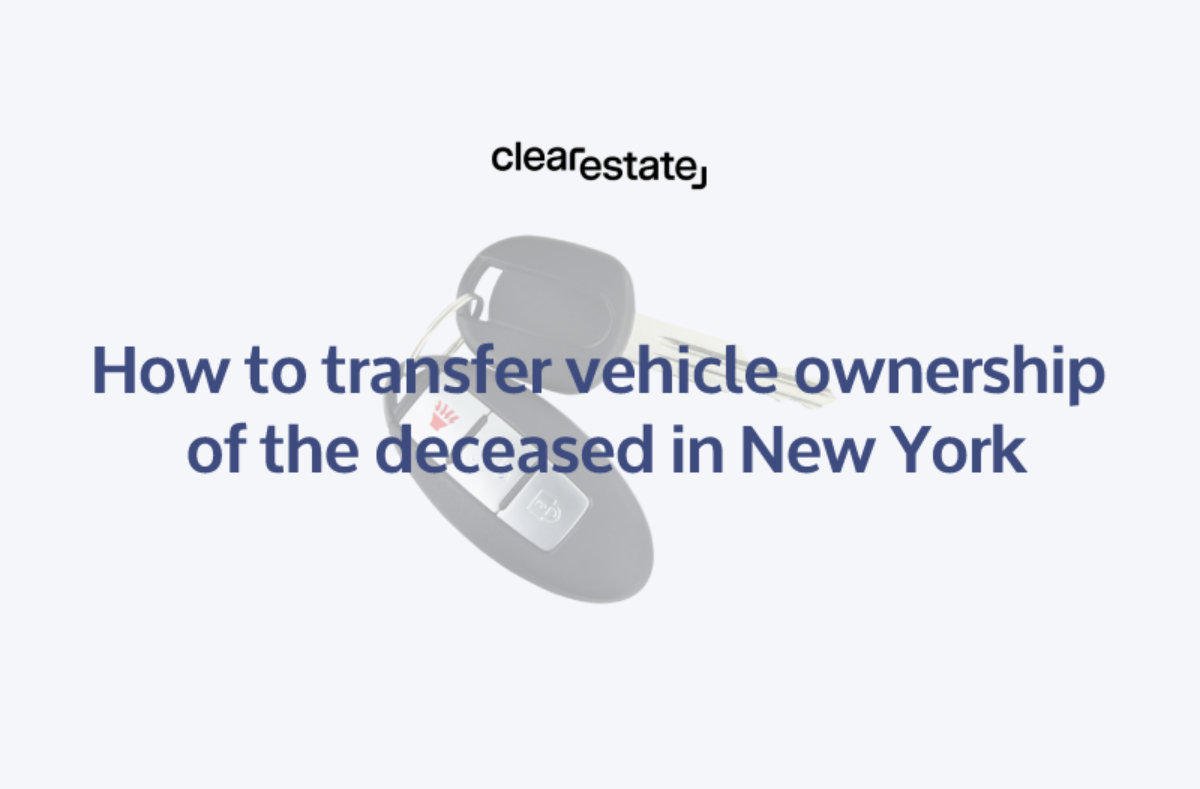Estate Settlement
May 01, 2025
What to Do When Someone Dies in California
Follow this step-by-step guide to navigate legal duties, probate, and estate tasks with clarity and confidence.
Transferring vehicle ownership of the deceased in New York? Our guide simplifies the process, ensuring you're well-informed every step of the way.


In New York, vehicle ownership transfer after the owner's death is a necessary legal process. Furthermore, a timely transfer prevents further mailings and identity theft and ensures the vehicle is free of financial debt.
After the death of an owner, you need to adhere to state-specific regulations in New York. If the vehicle is valued at less than $25,000, the next of kin may use form MV-349 (transfer of Vehicle Registered in the Name of Deceased Person).
For a surviving spouse or minor child, they use form MV-349.1, an affidavit for Transfer of Motor Vehicle. In some situations, probate may not be necessary if the estate is just the car valued under $25,000, and the transfer goes to the surviving spouse or minor children.
This guide will help you navigate all the DMV-related tasks and resolve any issues your loved ones might have with their driver's license, license plates, vehicle title, and transfer of ownership.
There are several steps and regulations involved in transferring ownership of a vehicle after the death of its owner in New York City. Depending on circumstances, such as inheritance or transfer to a surviving spouse or minor child, the New York DMV provides guidance and resources to facilitate these transfers.
As a general rule, the process involves:
The timely transfer of ownership, especially after a decedent's death, can prevent further mailings and identity theft and ensure that any obligations associated with the vehicle are cleared. Besides, you may be eligible for a refund of the registration fee.
Failure to transfer ownership can create legal repercussions and financial burdens for the estate of a dead person, including responsibility for:
As such, the New York DMV is helpful by providing guidance, checklists (form MV-843), and information about the procedures to be followed. It outlines the required documents and steps, such as proving identity ownership, releasing liens, and submitting a death certificate.
Depending on the circumstances, the New York Department of Motor Vehicles (DMV) requires different documents to transfer car ownership when the owner passes away. General requirements include the following documents:
There may be specific requirements depending on the circumstances.
1. Notification: Please send the DMV a copy of the death certificate and a photocopy of the deceased's license or ID (if you have one) to prevent future mailings and identity theft.
2. Gathering Documents: Here are the documents you will need:
3. Filling Out Forms: Along with the transferred Certificate of Title or Transferable Registration, you need one of the following:
4. Paying Fees: For surviving spouse only.
The surviving spouse will need to pay $10.00 to transfer their existing plates and a fee for any difference in weight between vehicles.
A survivor's spouse will be charged $25.00 for new plates and a 2-year registration fee.
Transferring "custom" or "personalized" plates requires applying through Albany's Custom Plates Unit.
The above fee information only gives you a rough idea of what to expect when transferring ownership. Make your check payable to the "Commissioner of Motor Vehicles," but do not put the dollar amount. An official from the Motor Vehicles office will calculate the exact amount and let you know.
5. Finalizing the Transfer: It is now time to contact the DMV. You can schedule an appointment and visit the DMV on the scheduled date. It saves you time and prevents you from waiting in line. Visit your local DMV's website to schedule an appointment in advance.
You may also mail the forms and documents directly to the DMV. If you choose to mail the documents, you must use the address on the form. Whenever there is a disagreement about ownership or ownership rights, you must wait for a court to resolve the matter. A DMV's expected timeline could vary depending on the complexity and volume of requests.
6. Receiving the New Title: After the paperwork is submitted and ownership has been transferred, the New York Department of Motor Vehicles (DMV) will issue a new title.
You'll get a new title mailed to the address you have on file about the new owner. Depending on how complex your case is and how many requests the DMV is processing, you may have to wait a while to get a new title. Get in touch with the New York DMV to find out how long it'll take to get a new title after a death.
There are many challenges that come with transferring a car after someone passes away, but here are a few and their solutions:
You need to ensure that all liens or loans against the car have been paid off before transferring ownership. To confirm that the title is lien-free, you can either obtain a statement from your lender stating that the loan has been repaid or contact the DMV.
When liens or loans are not properly cleared before transferring ownership, they can cause legal and financial complications. For example, a lender may still hold a legal claim to the vehicle if there is an outstanding loan, which may prevent the new owner from getting a clear title.
When a complex estate involves a deceased vehicle owner, it may be necessary to seek professional guidance.
Navigate the Complexities of Vehicle Ownership Transfer with Expert Guidance.
Dealing with the loss of a loved one is already challenging without the added burden of legal processes. Let our estate professionals guide you seamlessly through the intricacies of New York's vehicle title transfer.
Book a FREE consultation today and ensure you're on the right track in settling your loved one's estate. Your peace of mind is our priority.
 Simplify Probate Today
Simplify Probate Today
Get expert guidance from our specialists who've helped 10,000+ families.
Book a free consultation